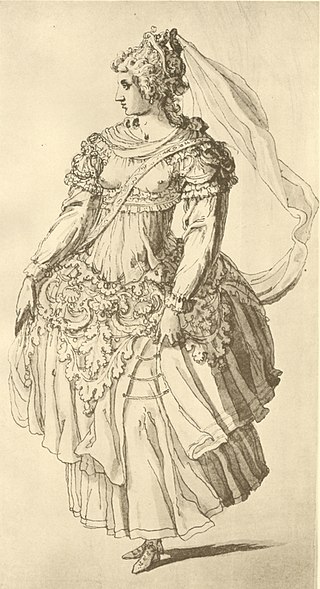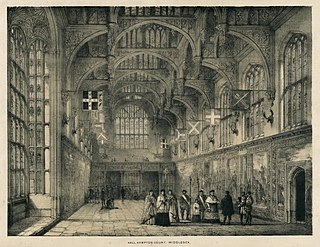
The masque was a form of festive courtly entertainment that flourished in 16th- and early 17th-century Europe, though it was developed earlier in Italy, in forms including the intermedio. A masque involved music, dancing, singing and acting, within an elaborate stage design, in which the architectural framing and costumes might be designed by a renowned architect, to present a deferential allegory flattering to the patron. Professional actors and musicians were hired for the speaking and singing parts. Masquers who did not speak or sing were often courtiers: the English queen Anne of Denmark frequently danced with her ladies in masques between 1603 and 1611, and Henry VIII and Charles I of England performed in the masques at their courts. In the tradition of masque, Louis XIV of France danced in ballets at Versailles with music by Jean-Baptiste Lully.

The Masque of Blackness was an early Jacobean era masque, first performed at the Stuart Court in the Banqueting Hall of Whitehall Palace on Twelfth Night, 6 January 1605. It was written by Ben Jonson at the request of Anne of Denmark, the queen consort of King James I, who wished the masquers to be disguised as Africans. Anne was one of the performers in the masque along with her court ladies, all of whom appeared in blackface makeup. In a ceremony earlier on the day, Prince Charles, Anne's second son was given the title of Duke of York.

Margaret Stuart, Scottish aristocrat and courtier in England. She served as lady-in-waiting to the queen consort of England, Anne of Denmark. She was the daughter of James Stewart, 2nd Earl of Moray, and Elizabeth Stuart, 2nd Countess of Moray. The sailor and patron of Ben Jonson, Sir Frances Stuart was her brother.
The Entertainment at Althorp, or The Althorp Entertainment, performed on 25 June 1603 is an early Jacobean era literary work, written by Ben Jonson. It is also known as A Particular Entertainment of the Queen and Prince, or The Satyr. The work marked a major development in Jonson's career, as the first of many entertainments and masques that he would write for the Stuart Court.
The Memorable Masque of the Middle Temple and Lincoln's Inn was a Jacobean era masque, written by George Chapman, and with costumes, sets, and stage effects designed by Inigo Jones. It was performed in the Great Hall of Whitehall Palace on 15 February 1613, as one item in the elaborate festivities surrounding the marriage of Princess Elizabeth, daughter of King James I, to Frederick V, Elector Palatine in the Rhineland.
The King's Entertainment at Welbeck in Nottinghamshire, alternatively titled Love's Welcome at Welbeck, was a masque or entertainment written by Ben Jonson, and performed on 21 May 1633 at the Welbeck estate of William Cavendish, 1st Duke of Newcastle. It has been argued that the philosopher Thomas Hobbes may have participated in the entertainment as a performer.
The Gypsies Metamorphosed, alternatively titled The Metamorphosed Gypsies, The Gypsies' Metamorphosis, or The Masque of Gypsies, was a Jacobean era masque written by Ben Jonson, with music composed by Nicholas Lanier. It was first performed on 3 August 1621, and was the biggest popular hit of Jonson's masquing career.

Thomas Somerset, 1st Viscount Somerset (1579–1651) was an English politician who sat in the House of Commons between 1601 and 1611. He was raised to the Peerage of Ireland in 1626.

Tethys' Festival was a masque produced on 5 June 1610 to celebrate the investiture of Prince Henry (1594–1612) as Prince of Wales.
Sir Edward Zouch of Woking was a courtier to English kings James and Charles I, a masque actor, and Knight Marshal of the King's Household.
Mary Middlemore was a Courtier and Maid of Honour to Anne of Denmark, subject of poems, and treasure hunter.
Dorothy Hastings was a courtier to Elizabeth I of England and Anne of Denmark
Charles Cauchon de Maupas et du Thour or du Tour (1566-1629), was a French ambassador to the Scottish and English court of James VI and I.
John Wolfgang Rumler was a German physician and apothecary in Augsburg, known for his Observationes medicae, who eventually served the English royal family in the households of Prince of Wales, Queen Anne, King James and Charles I of England. He is also credited with making blackface theatrical grease-paint.

Prince Henry's Welcome at Winchester was a masque produced by Anne of Denmark and performed in 1603 at Winchester on a day between 11 and 17 October.

The Masque of Indian and China Knights was performed at Hampton Court in Richmond, England on 1 January 1604. The masque was not published, and no text survives. It was described in a letter written by Dudley Carleton. The historian Leeds Barroll prefers the title, Masque of the Orient Knights.

The wedding of Elizabeth Stuart (1596–1662), daughter of James VI and I, and Frederick V of the Palatinate (1596–1632) was celebrated in London in February 1613. There were fireworks, masques, tournaments, and a mock-sea battle or naumachia. Preparations involved the construction of a "Marriage room", a hall adjacent to the 1607 Banqueting House at Whitehall Palace. The events were described in various contemporary pamphlets and letters.
The Entertainment of the Two Kings of Great Britain and Denmark or The Hours was written by Ben Jonson and performed at Theobalds House on 24 July 1606. John Harington of Kelston described another masque of Solomon and Sheba, performed one day at Theobalds after dinner. There is some doubt over Harington's account. In May 1607 another masque An Entertainment of the King James and Queen Anne at Theobalds was performed when the keys of the house were given to Anne of Denmark.
Captain Cox of Coventry was an English collector of ballads and romances. He was present at Kenilworth on Queen Elizabeth's visit in 1575 and took a leading part in one of the royal entertainments.

The Masque of Flowers was an entertainment on 6 January 1614 to celebrate the marriage of Robert Carr, 1st Earl of Somerset and Frances Howard, Countess of Somerset.










